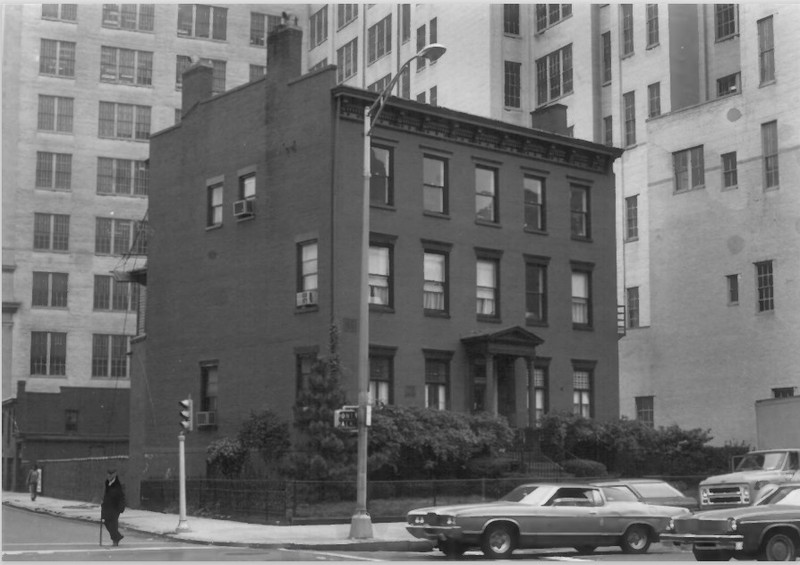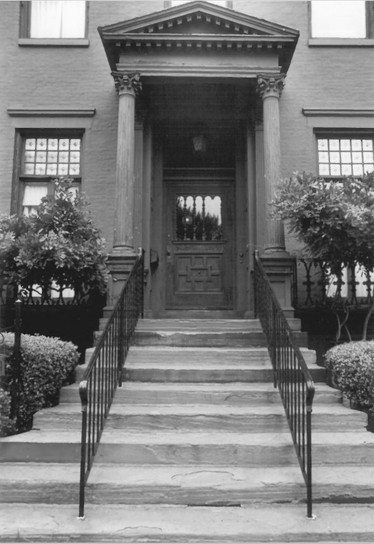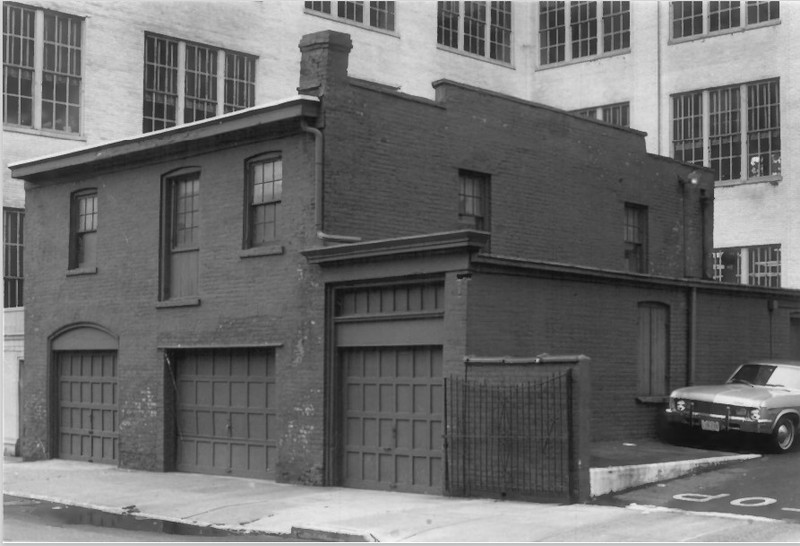Symington House
Introduction
Text-to-speech Audio
Images
Symington House in 1976 photo, looking east; carriage house/garage far left (NPLC and Karschner)

1976 photo of Symington House front entrance, for nrhp (NPLC and Karschner )

Carriage house/garage behind Symington House, along Rector Street, in 1976 photo (NPLC and Karschner)

Backstory and Context
Text-to-speech Audio
Before the Symington House was built, a Dutch colonial farmhouse/ cottage reportedly stood on this spot; a portion of its foundation was incorporated into the front foundation of the 1808 house. Trinity Church was the first Episcopal church in Newark. The parish formed a building committee in 1807 to plan for a new parsonage house/ rectory. The brick, three-story parsonage (later called Symington House) was finished in 1808. Trinity Church had been damaged during the Revolutionary War and the church was rebuilt in 1809.
The typical Federal design shows in the house's five-bay-wide symmetry. The central entrance porch at the top of brownstone steps has Corinthian fluted columns supporting a dentilled pediment. The wooden cornice supporting the roof has dentils with brackets and carved rosettes. A pair of chimneys on each side pierce the low-pitched roof. The foundation is brownstone. The cooking fireplace was in the basement of the original design of the house.
A banker and member of the Episcopal Church Vestry, Daniel Dodd, bought the house in 1879. Dodd was a widowed 60-year-old bank president in 1880 when the U.S. census was taken. Dodd shared his home at 2 Park Place with his three children: Margaret C. (age 24, no occupation), Mary A. (14) and Daniel (Jr., 18); all were New Jersey natives. Four servants completed the household: nurse Eliza J. Charles (50), cook Mary O'Donnell, waitress Mary Mooney (18) and laundress Katie Dolan (22).
Robert B. Symington was born in Scotland in 1852 and emigrated to the U.S. in 1873. His wife, Jeannie, was a Scottish native who was born in 1853 and emigrated to the U.S. in 1878. The couple married in 1878 and only had one child, a son named William C. ("Clark"), who was born in New Jersey in 1879. All three occupied the 2 Park Place home in 1900; Robert was a 48-year-old manufacturer of spool cotton. William, age 20, attended school for nine months of the year. Four servants also lived in the Symington home: Mary Giffney (26), Christine Anderson (52), Mary A. Kyle (17) and John Dunkin (38). Ten years later, the three Symingtons lived in the 2 Park Place home with five new servants; Robert was a spool cotton merchant in 1910 and William was a manufacturer of scales. The Symington household did not appear in the 1920 census. Robert had died by 1940, when William headed the household at 2 Park Place; the 60-year-old manufacturer of instruments was still single, and shared the home with his widowed mother, Jean (88); Jean's widowed sister or a nun, Mary L. O'Malley (90); a lodger, Arthur Honsell Jr. (30); and two servants (a maid and a cook). By 1942, the widowed Jean Symington shared the 2 Park Place home with her son, William, who worked in New York City; and Ruth Symington (presumably William's wife), a nurse at Presbyterian Hospital. The 1947 city directory only lists William at the 2 Park Place residence.
Symington House underwent interior renovations after Robert B. Symington purchased the mansion from Dodd in 1888. A new cooking kitchen was added to the basement. The family also replaced the original 6-over-6 windows with single large panes, and removed the exterior window shutters. Some of the first floor windows were replaced with French doors topped by purple stained glass, leading to a cast iron veranda across the home's front. A large carriage house made of brick stands to the rear of the Symington House and was converted into a garage.
William (Clark) Symington's widow still owned the house in 1965 when she sold it to the Continental Insurance Company. The firm used the building for additional office space to rent out; the property became known as Continental House. The insurance company had already built a skyscraper adjacent to the house. Additional restorations were made when the building was used as part of the 300th anniversary of Newark celebrations in 1966. The house became the temporary headquarters for the Newark Tercentennial Committee. The mansion later became an office and training center for business leaders. When Symington House was documented for the National register in the late 1970s, only two standing houses in Newark were older: the Plume House and the Sydenham-Henderson House. The Episcopal Diocese of Newark purchased the mansion and it briefly held St. Philip's Academy in the 1990s.
Sources
Newark Preservation and Landmarks Committee (NPLC). Karschner, Terry. NRHP Nomination of Symington House/ Continental House, Newark. National Register. Washington, DC. National Park Service, 1977.
Newark Public Library. Architectural Splendors that Once Graced the City's Streets, Knowing Newark: History and Landscape. August 6th 1998. Accessed February 2nd 2021. https://knowingnewark.npl.org/architectural-splendors-that-once-graced-the-citys-streets/.
New Jersey Institute of Technology. Symington House, Digital Archive of Newark Architecture (DANA). January 1st 2019. Accessed February 2nd 2021. https://dana.njit.edu/items/show/389.
Price & Lee Company. Newark Directory 1942. Newark, NJ. Price & Lee Company, 1942.
Price & Lee Company. Newark Directory 1947. Newark, NJ. Price & Lee Company, 1947.
U.S. Census. Household of Daniel Dodd at 2 Park Place, Newark District 21, New Jersey, dwelling 158, family 199. Washington, DC. U.S. Government, 1880.
U.S. Census. Household of Robert B. Symington at 2 Park Place, Newark Ward 1 District 8, New Jersey, dwelling 112, family 128. Washington, DC. U.S. Government, 1900.
U.S. Census. Household of Robert B. Symington at 2 Park Place, Newark Ward 1 District 6, New Jersey, dwelling 52, family 62. Washington, DC. U.S. Government, 1910.
U.S. Census. Household of W. Clark Symington at 2 Park Place, Newark Ward 4 District 25-82, New Jersey, Washington, DC. U.S. Government, 1940.
https://npgallery.nps.gov/AssetDetail/NRIS/79001487
https://npgallery.nps.gov/AssetDetail/NRIS/79001487
https://npgallery.nps.gov/AssetDetail/NRIS/79001487
